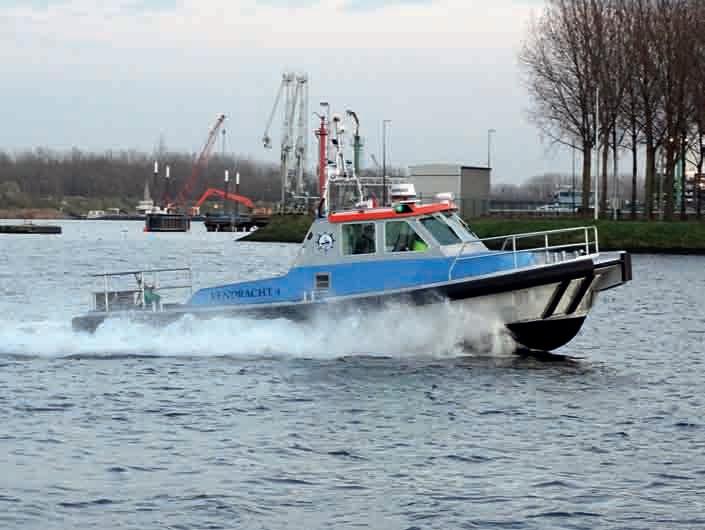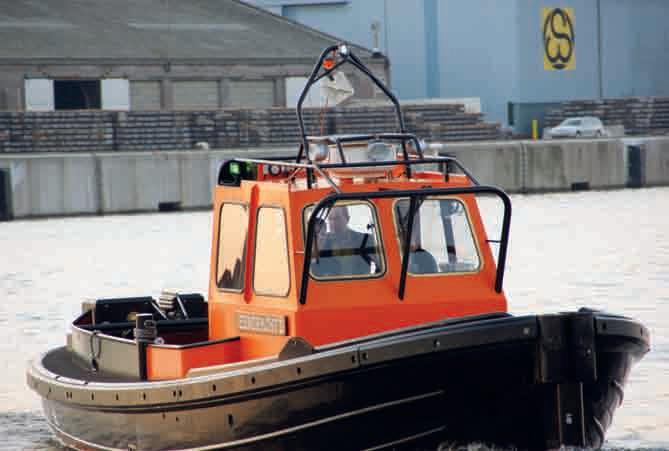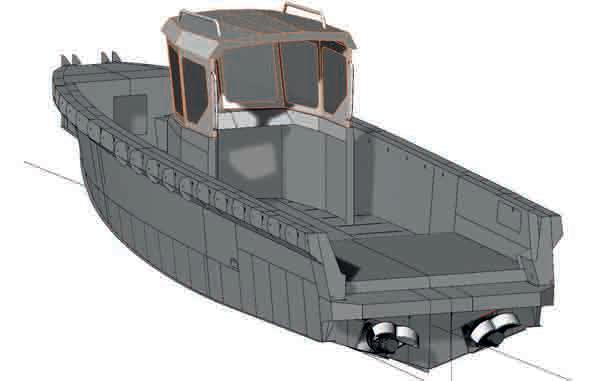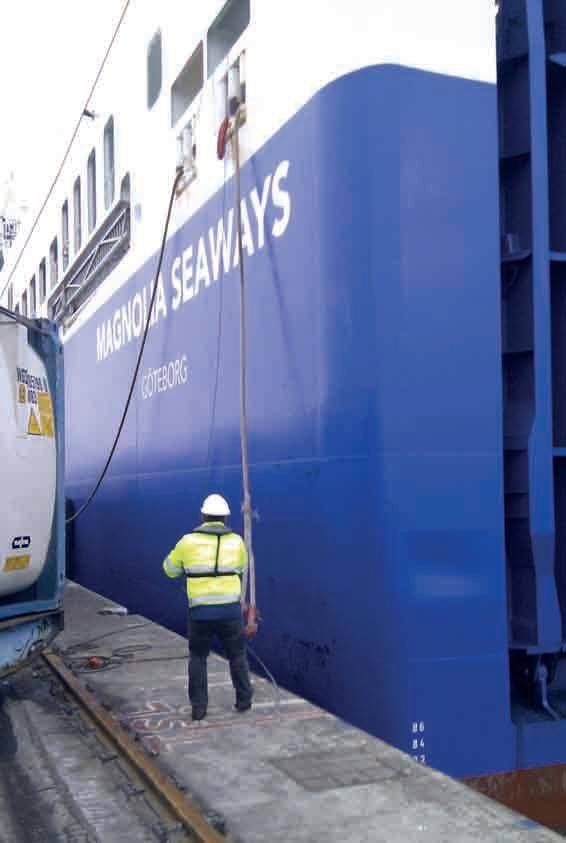
8 minute read
Safe berthing and unberthing
Safe berthing and unberthing since 1923
De Eendracht takes care of the safe mooring and unmooring of vessels in the Ghent port area. This activity already dates back to 1885, with boatmen helping sailing vessels with safe berthing and unberthing. A lot has changed since those days though.
“Mooring and unmooring has always been an important activity in the port area, as this contributes to safe traffic in the docks and the Ghent-Terneuzen Canal”, says Alain van Gelderen, General Manager of De Eendracht. “In the nineteenth century various people provided boatmen services, but in 1923 all activities were legally combined into one company: De Eendracht (meaning unity).” De Eendracht today still remains a company with limited liability, with eight partners of which each person has a specific responsibility. Mr Van Gelderen is one of them. “In our organisation, this partnership is still a family matter for all partners. I started my career at De Eendracht as boatman in 1987 and after some years succeeded my father as shareholder. We have thus been always a privately-owned company.”


TODAY, NORTH SEA PORT REQUIRES ALL VESSELS WITH A LENGTH OF AT LEAST 240M OR A 32M BEAM TO BE ASSISTED BY A WHEELMAN.
TODAY, DE EENDRACHT ALSO RENTS WORKBOATS AND BARGES.
All Photos except aerial, courtesy of De Eendracht.

THE EXISTING FAST BOAT ALSO OPERATES AS AN INTERVENTION VESSEL FOR NORTH SEA PORT.
explains, “Our wheelmen go on board of the vessels departing from Ghent, where they take over the helm to assist the pilot to help the vessel sail safely through the Ghent-Terneuzen canal and onto the Western Scheldt for their final destination. Our Terneuzen colleagues operate on the incoming vessels. Today, North Sea Port requires all vessels with a length of at least 240m or a 32m beam to be assisted by a wheelman, but for other smaller vessels our wheelman assistance is also often requested so as to avoid any risk.”
Geographical region Looking at the boatmen services, more than 3,000 vessels are assisted each year. “Every seagoing vessel longer than 80m requires our help”, states Mr Van Gelderen. As a cross-border region, North Sea Port has a unique situation of having several boatmen services. One in Vlissingen, two in Terneuzen, and one in Ghent. “For us, the merger of Zeeland Seaports and the Port of Ghent was not really a big change. Because we are neighbours alongside the same canal, there has always been ample collaboration between the various organisations and authorities in the cross-border region. As we are all connected to, and dependent on, a good working maritime chain. We consider this a high priority. It is positive to notice that this collaboration has become more and more common use.”
Last-minute planning Mr Van Gelderen explains that the boatman services are always a matter of short-term planning. “Our port area,” he says, “consists of quays alongside a number of docks and the canal. So, there is not much room for vessels to wait. For us, this means that our boatmen services are always a last-minute job in which the last five minutes are the most important. As soon as the vessel is close to the quay of destination, we must respond immediately. Fortunately, we can follow the process
DE EENDRACHT TAKES CARE OF THE SAFE MOORING AND UNMOORING OF VESSELS IN THE GHENT PORT AREA. THIS ACTIVITY ALREADY DATES BACK TO 1885.

from the moment the vessel enters the North Sea Port area. For this task, we are connected to North Sea Port’s Enigma port management system, which is very adequate.”
Other services The boatmen and wheelmen services are only two activities in the long range of tasks the company is aiming at. “In 1987, we moved to our current location and from here, we have expanded our activities towards other services”, Mr Van Gelderen comments. “Today, we rent working boats and barges, offer anchor handling services, and deliver goods such as provisions to, for example, vessels at the oiltanking jetty and other locations that are difficult to reach by truck. Fifteen years ago, we started to take care of the collection of household garbage from vessels by offering the use of small 1,100l containers. Vessels can now leave their garbage in the port very easily. In the beginning we handled about 30 containers per month, now we do more than 200. Next to this, we also have a taxi service to take crew to destinations on shore, for example to the airport, doctor or dentist. We started this taxi service to absorb peaks and troughs. Boatmen waiting for vessels can meanwhile drive people around, but it has now become a valued service for visiting crews. Our people know the port very well, so they can transfer crew fast and efficiently.”
BOATMAN SERVICES ARE ALWAYS A MATTER OF SHORT-TERM PLANNING.

Challenges When asked about today’s challenges that De Eendracht has to deal with, Mr Van Gelderen mentions four. “Many companies in our port area do not really know what we do. Many of them ask us to follow security rules that are not relevant for us. Why
A HIGH-SPEED WORKBOAT, ENTIRELY MADE OF HDPE, IS CURRENTLY UNDER CONSTRUCTION AT TIDEMAN BOATS IN THE NETHERLANDS, AND IT WILL BE AVAILABLE IN JULY.

should we know how to park a truck on a terminal? We are not truck drivers and only operate on the quay. These measures are not efficient and often time-consuming.” As a second challenge, Mr Van Gelderen mentions the new lock that is currently under construction near Terneuzen. “With the new lock, capacity at the lock system will rise. Of course, more vessels are good for us and we are very happy about that, but not when this leads to big fluctuations of traffic with higher peaks resulting in higher variation in demand for boatmen. It is good to see, however, that a lot of attention is already paid to this by those parties concerned, and boatmen services are considered as an equal partner in the chain.”
Five years A third challenge is employment. “In general terms,” Mr Van Gelderen says, “people tend to leave a company and switch to another job after only a few years. This is not really in line with becoming a boatman, as this job requires an expensive and year-long training. It will take two years before you are able to work without someone keeping an eye on you, and only after five years will you become a fully operational, independently acting boatman. Working as a boatman means you will never have a dull moment. It is a job with abundant challenges, responsibility, and individual operations, and this is something not everyone can handle. But it is good to notice that we are still able to find the right people.”
High-speed vessel The fourth and final challenge that Mr Van Gelderen recognises is the increasing road traffic in and around the Ghent port area. “More and more cars and trucks are moving around in our region, resulting in congestion in and around the port. As there are not many alternative routes available, this hinders our work. That is one of the reasons why we decided to invest in a new fast vessel. This high-speed workboat, entirely made of HDPE, is currently under construction at Tideman Boats in the Netherlands, and it will be available in July.” De Eendracht presently has four vessels on hand. Three flat boats and one high-speed vessel, and the new Tideman boat will replace one of the flats. “Our existing fast boat also operates as an intervention vessel for North Sea Port, so it must be available 24/7, resulting in limited deployability. The new high-speed vessel will give us the extra capacity needed to be able to move around fast and flexibly in the port.”
SINCE ESTABLISHMENT IN 1923, NOT A SINGLE HOUR OF DELAY TO SHIPS WAS CAUSED BY DE EENDRACHT.

Fixing a vessel The job of the boatmen has not changed a lot over the years, according to Mr Van Gelderen. “Basically, mooring and unmooring has always been a matter of fixing a vessel to the quay with a rope”, he states. “Apart from the fact that we now use winch trucks when necessary, not much has changed. Two boatmen are needed for a smaller vessel, four for middle size vessels, and for the larger ones we use four boatmen and the two winch trucks. Vessels do grow in size, hence using bigger lines, but this does not always mean that the lines become heavier and more difficult to handle, as lightweight material is in use now for modern lines, such as, for example, Dyneema.”
Top priority One thing about De Eendracht boatmen services that has not changed over the years either is the high sense of safety. “The circumstances we are working in are not without risks”, Mr Van Gelderen states. “I know this from my own experience. Therefore, we have always paid a lot of attention to safety. As a result of this, we have now been operating for many decades without serious injuries. It is good to notice that our boatmen take their job very seriously. Since our establishment in 1923, not a single hour of delay to ships was caused by us and that is something all of us can be very proud of.”










